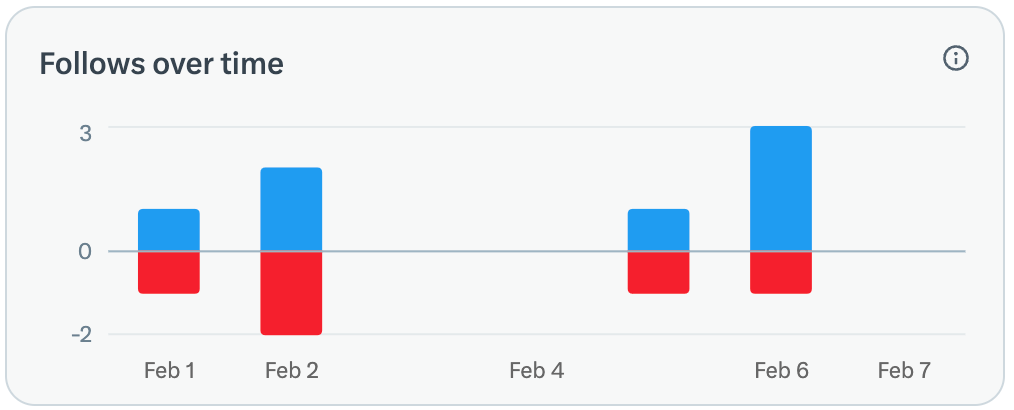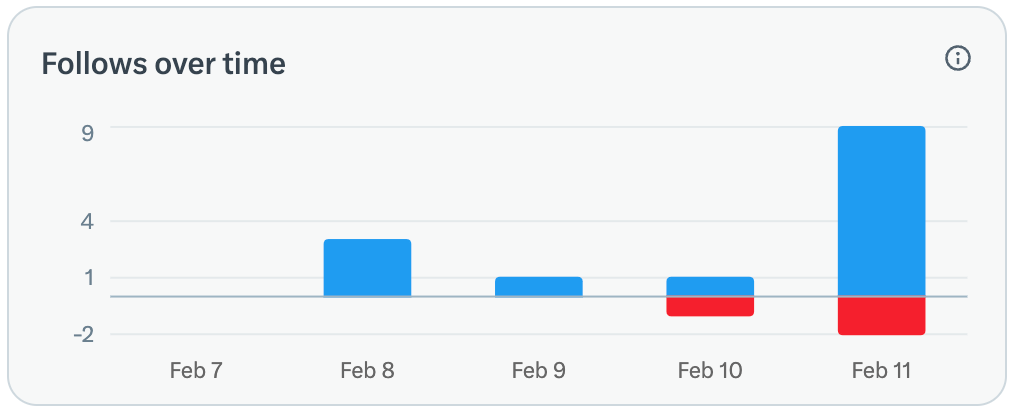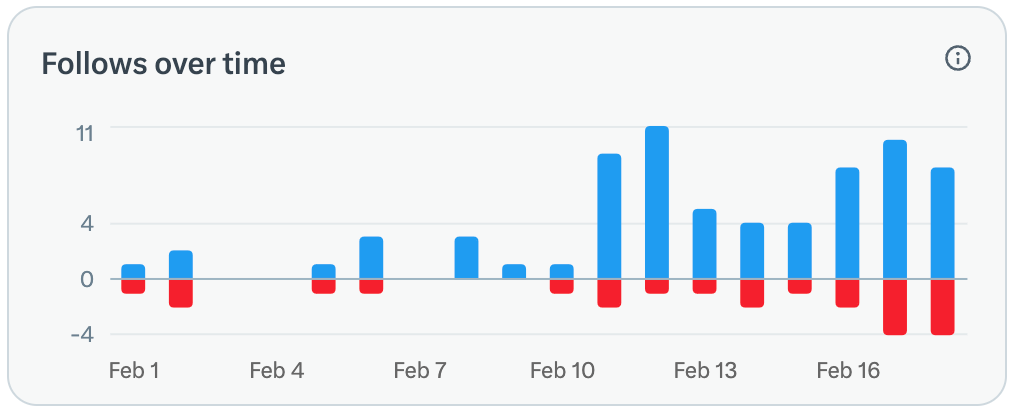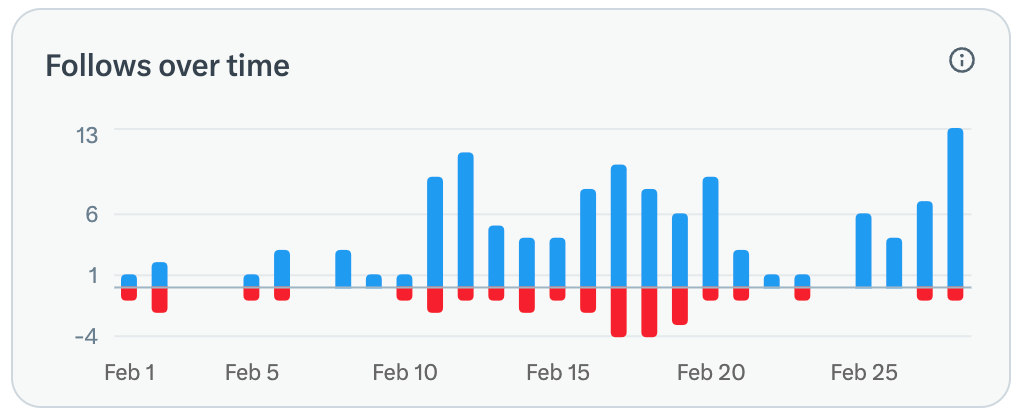February has been another wild month in my new Twitter/X quest. If last month was about dipping my toes into the swampy waters of social media, this month was about wading in deeper, getting a bit muddy and then realising that I might have just found a few dry stepping-stones to get me across to the other side.
Pivoting from the Scheduled Posting Approach
As I mentioned last time, starting from a tiny follower-base in month one, I managed to grow the number of authentic followers by 60% - a number I was both happy with and thought I may be able to repeat in month two.
Yes, 60% was ambitious but it felt possible … at least at the time.
Week One Woes
At the start of February, I carried on as normal - churning out content, posting daily, and, basically hoping for the best. But the engagement? Small.
After one week, I had gained 7 followers and lost 5 - so +2 followers.
Given my 60% growth target, I was 25% of the way through February but only 3% to my target! Not good, I needed to try something else.
If At First You Don’t Succeed … Try Throwing Money At It
After having written a (semi) popular thread about GitHub contributions in Europe vs. the US and UK (data-driven, visually snappy, topical), I felt like I had a solid candidate to try ‘boosting’.
‘Boosting’ is essentially X’s paid-advertising model where you can pay to have your content displayed to more users in exchange for cold-hard-cash. I know at some point I may want to use paid advertising to sell things, and so I was curious to try this out in anger. I’m not keen on throwing cash at this long-term, but I figured a modest $50-$100 could bootstrap my audience and give me a crash course in online advertising along the way.
The first campaign (Feb 7th) was a bit of a trainwreck; the X interface is pretty unclear (at least to a newbie) and I struggled to target the content to the relevant audience. After this failure, I grokked a few marketing resources and reconfigured my ad - the second campaign (Feb 10th) was definitely more successful but was still an extremely inefficient use of capital in terms of number of valuable accounts reached.
It’s now Feb 11th and I’ve acquired 11 followers - this is about 27% of my way to the goal. Not horrific but not on target for success.
You just need to do it more
Mid-month, I stumbled across a comment from another startup/tech account describing how he’d finally gotten some uptake: be more active. To be honest, it sounded almost insultingly obvious - reply more, engage more, just do more. But after reading through the open-sourced ranking algorithm, it did make some sense: I’d been dutifully posting every day but I wasn’t networking. X is a social network, after all, and the algorithm loves a chatterbox.
So, I ditched the old approach and committed to making 25-30 replies a day to relevant accounts in my niches—Tech, AI, Innovation, Europe, etc. To my surprise … it worked!
Within hours of starting, I’d been quoted by @levelsio (a big-deal account with a massive following). That single reply netted me more followers than my promoted post did in two days. Maybe I was on to something?
The results were steady, consistent growth, real engagement, and best of all, actual conversations with smart, funny, influential people. It’s not an experience I’ve had anywhere else online tbh.
I kept it up for a week, turning it into a game: each day, I’d aim for five more “reps” (replies) than the day before. Between Feb 11th and Feb 18th, I had acquired an additional 35 followers!
Not only was the 60% target looking achievable, I was likely to overshoot! 🚀💪
The Engineer Strikes Back
Scrolling aimlessly through my feed to find reply-worthy posts was getting inefficient. By the time I chimed in, conversations were often stale, and I needed a system if this was to work for more than a few weeks. Here’s roughly what I came up with:
Reply-o-Tron 3000™
Identify role models: I picked accounts I admire and want to emulate.
Dig into their networks: I scoured their followers and following lists for gems.
Build three lists: I sorted 75 accounts into Low (1-10k followers), Med (10-50k), and High (50k+). That’s the sweet spot I can handle while keeping my replies sharp and authentic.
Leverage X features: I used the Lists tool to organize them and the X Pro dashboard to monitor all three at once—like multi-tabling in my old online poker days.
Timebox it: I set aside two hours daily (one at EU midday, one at US midday) to dive in, reply, like, repost, and follow.
This kicked things up a notch. Regular engagement started paying off, and - surprise - I was now noticing some of my standalone posts (not replies) were gaining a small amount of traction. For the first time, they weren’t just ghosting into the void.
I needed to capitalise on this if possible.
The Stripe Thread: Timing Is Everything
I decided to attempt one more high-effort thread. I wasn’t sure exactly what the topic would be, but then, as if by magic, Stripe (a multi-billion-dollar fintech company) dropped their Annual Letter!
It’s a fantastic letter, and for anyone starting an online business, I’d highly recommend staying on top of anything Stripe publishes - their size and scale means they have economic insights that no-one else can match.
What was most interesting was that, despite being US-centric, around 30% of their letter was dedicated to the problem of EU growth, pinpointing opportunities and bottlenecks in the region’s tech and finance ecosystem. This was extremely relevant to me: Tech, Finance, Europe, Innovation—all the things I’ve been talking about.
So, what to do? Speed-read it, distill it into a punchy, digestible thread with a few punchy visuals, and tweet it out before the masses jumped on the bandwagon.
I pulled it off. Within minutes, Patrick Collison (Stripe’s co-founder with 500k+ followers) had liked it. That like seemed to be a bat-signal to the algorithm - “This is good stuff” - and the thread started popping up in high-value feeds.
The thread caught the eye of an Irish News company, who reposted it on their X account as part of a segment on Ireland’s role in Europe’s fintech boom. A European think tank focused on digital policy also shared it, framing it as a “must read”.
Then Andreas Klinger, a linchpin in EU tech innovation with 60k+ followers, retweeted it to his network of policymakers and VCs. He even slid into my DMs with some kind, practical tips on sharpening up my content for the EU growth crowd - absolute gold.
Suddenly, my little thread was bouncing around newsrooms and policy circles. The result? A (small) flurry of new followers and - better yet - a budding network of high-quality contacts tied to the “grow Europe” mission.
Even including four days away from X for personal reasons, the final week-and-a-half was enough to push me comfortably across the finish line with +42 followers and smashing my original target - I hit 186%!
Conclusion
My account is still minuscule and there is a long way to go. The process of building an online audience is more art than science, but it’s becoming clear to me now that certain aspects of it can be wrapped in processes that make things more reproducible.
I’m going to aim for 60% again in March. This may seem cowardly given this month’s results but, now that the baseline is getting bigger, I may struggle to keep hitting 100% gains. On the flip side, a bigger audience and network effect may actually accelerate things … I guess we’ll find out in about four weeks.
I’ve also landed a Fractional-CTO gig with a small health-tech startup - one day a week, nothing crazy, but it’ll nibble at my time. Balancing that with X and other things should keep me on my toes.
For now, I’m going to take this as a small victory whilst remembering to keep in mind that I’m still a pico-account and have a lot to learn.
I’m pleasantly surprised that it’s been possible to apply aspects of my research-driven, engineering mindset to generate solid results in a domain I’d previously thought was completely driven by emotion (or at least impossibly complicated algorithms that would be impossible to crack).
Thanks for reading.
Automation Consultancy ⚙️🚀
Codefield helps businesses build and implement automated solutions for an extremely wide range of challenges.
Regardless of sector or size, we find that there are many, many places where leveraging Automation and AI can help businesses reduce (or even eliminate) the time spent on repetitive and/or tedious tasks, allowing them to focus on the more valuable strategic work that takes the business forward.
If you think there are areas of your business that could be automated or streamlined, then feel free to reach out for a friendly (and in no way pushy) chat at automation@codefield.io











